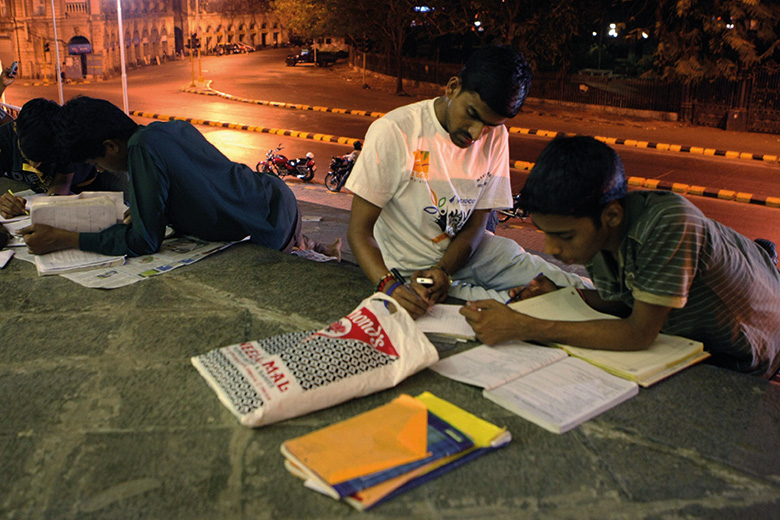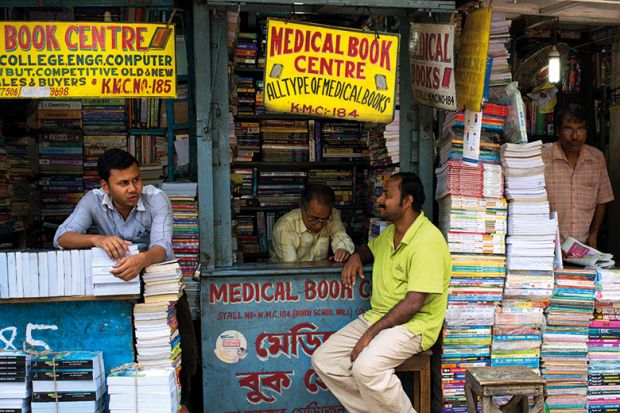College Street in Kolkata is a real place, but it is also something of a myth. The cradle of the 19th-century Bengal Renaissance, it runs past the historic Presidency College and the University of Calcutta, as well as a host of other institutions that came together to shape the identity of modern Bengal, and to an extent, that of modern India. But the most visible marker of College Street is the dense cluster of makeshift wooden stalls that fringe its pavements. These are similar to those found elsewhere in the city. But instead of selling T-shirts and sunglasses, College Street specialises in books.
As you make your way down the street, you’re coaxed, cajoled and beckoned as you try to slide past these stalls, and volumes are thrust at your face with much force and noise. But while it has been like this for decades, the kinds of books you are accosted with have changed. Back in the mid-1990s, when I roamed these streets as a college student, you might have been confronted with Proust, Borges or Neruda. Fast forward two decades and what comes flying at you are, instead, coaching manuals and test prep volumes promising to crack the codes for success in modern India – entrance exams for engineering, medicine and management schools, or the prerequisites for entering American universities: the GRE, GMAT and SAT.
The undiminished intensity of salesmanship reflects all the fervour of educational and professional upward mobility in 21st-century India. If you still possess remembrance of things past, these days you simply order them online. But even back in my day, the College Street bookstalls bore witness to the fact that there was not such a deep rift between the literary-aesthetic and the competitive-professional in Indian educational history as one might think.
For while we English literature students bought our volumes of Keats and Byron in College Street, we also made pilgrimages there in search of anthologies of a less poetic nature: bundles of historical University of Calcutta exam scripts. This was because our entire undergraduate grades depended on how well we did in a series of three-hour examinations held over a period of about a week on two occasions during the three-year course. If your college wasn’t particular about attendance, you could be in Alaska for the rest of the time, or, for that matter, hold down a full-time job.
The essential academic skill was the ability to second-guess the examiners. Would that question on Conrad’s prose style show up this year? What about the one on symbolism in Yeats? It was wise to discount the questions that had been set the previous year, as we were assured that the authorities did not like to repeat questions in successive years. So questions from odd- and even-numbered years did not mingle in the same question set. Since our English BA Part I was to be held in an odd-numbered year – 1995 – I zealously prepared the answer to a question on the tragic structure of J. M. Synge’s Riders to the Sea that had first appeared, with the exact same wording, in 1943.
If this mechanical approach seems particularly ironic with a subject such as English literature, it is hardly a surprise given the history of the modern Indian university. The renowned Indian sociologist André Béteille has reminded us that the colonial universities set up by the British in the 19th century could not be more different from the centres of higher learning that had already existed in Western Europe for centuries. Moreover, the mission of the research university – which originated with Wilhelm von Humboldt’s reformed University of Berlin in the early 19th century and was introduced later in the century into the US through the establishment of Johns Hopkins University – bore no relation whatsoever to India’s colonial universities.
The first universities that were established in 1857 in the three presidencies of (as they were known then) Calcutta, Bombay and Madras, were “set up primarily for conducting examinations and awarding degrees, and not for undertaking research or even teaching”, Béteille writes. Research was instead confined to specialised institutions, such as the Asiatic Society or the Indian Association for the Cultivation of Science, while teaching was left to the colleges.
The historian Suresh Chandra Ghosh has pointed out that the preamble to the Acts of Incorporation that established those first colonial universities were identical. They all defined the objects of the institutions as “ascertaining by means of examination the persons who have acquired proficiency in different branches of Literature, Science and Art and rewarding them by Academic Degrees as evidence of their respective attainments”. As Ghosh indicates, it wasn’t long before this narrowness came under attack. A State Paper on Education, commissioned by India’s governor-general in 1904, complained that “excessive importance was given to examinations” and that “higher education was pursued with too exclusive a view to entering government service, which unduly narrowed its scope, and those who failed to obtain employment under government were ill fitted for other pursuits”.

Clearly, the British did not believe that the university as a place for higher learning and research could take root in India. Nor did the British undergraduate college, with its mission of pastoral care embodied in student residential life – as illustrated by the colleges of Oxford and Cambridge – find systematic root in the subcontinent. This is not to imply, Béteille reminds us, that Indian universities had no salutary role in society. They were important venues of secular modernity, and played a distinctive role in the shaping and sustaining of a civil society in India. Moreover, a few Indian universities had emerged as centres of intellectual and scholarly excellence by the early 20th century. But, by and large, “under colonial rule, the universities did mainly what they were set up to do, that is, produce increasing numbers of graduates of indifferent quality”, Béteille says.
So if the great public universities in India are routinely blamed for their lack of innovation, pedagogic vitality and research productivity, such inadequacies have much deeper roots than the general underdevelopment of the nation; they are specifically traceable to the original British colonial structure, which independent India has done little to change. Even Jawaharlal Nehru’s great socialist vision for higher education, which shaped the birth of the University Education Commission in 1948 under the leadership of Sarvepalli Radhakrishnana, failed to transform this fundamental character of Indian universities. Decades after independence, the expansion of higher education continued to respond to social and political pressures, rather than to the need for the advancement of knowledge. Notwithstanding genuine efforts by the leaders of the scientific and scholarly community, the public universities have failed to free themselves from their historical imperative to produce more and more graduates.
Looking back on my undergraduate years, I now realise that I studied a liberal arts subject without receiving a liberal arts education. And I also realise why that was. English literature was at the heart of the imperial mission. It was expected to support the colonial rulers’ aim to “civilise” and was accordingly assigned a strategic place in the examinations one had to pass to be appointed to government service. There is now a scholarly consensus that English as an academic subject was instituted first in colonial India in the 1820s – by Thomas Babington Macaulay, who was then a member of the Supreme Council of India – at a time when the classics still dominated university curricula in England. It is equally clear that this institutionalisation of English literature was part of an exercise in a kind of professionalisation of India, the anachronistic remains of which continue to live on in the country’s examination-centred curriculum and pedagogy long after its colonial-bureaucratic applicability vanished with the disappearance of British rule.
Part of the confusion between approach and discipline that shapes the popular understanding of “liberal arts” stems from the fact that the term itself embodies a nomenclatural anachronism. The term “arts” simply recalls a time when the sciences were “arts” too. It is scarcely remembered today that the word “scientist” was coined in the 19th century by analogy to the word “artist” (as cultural critic Marjorie Garber reminds us in her 2001 book Academic Instincts, the deliberating members of the British Association for the Advancement of Science felt that “philosophers” was “too wide and too lofty” while “savans was rather assuming”). Nor is it often recalled that the liberal arts have their roots in Roman trivium (grammar, logic and rhetoric) and quadrivium (music, arithmetic, geometry and astronomy), which were also studied in medieval European universities and which very much included what we would now call the sciences.
The modern view of the liberal arts not as an inventory of specific subjects but as an educative approach took root when the Oxbridge model of pastoral undergraduate care developed into a wide range of liberal arts colleges across the US. And science’s inclusion in most modern liberal arts programmes reflects the fact that an ideal liberal education incorporates intellectual breadth alongside disciplinary specialisation.
The bureaucratic-instrumental character of the modern Indian university has more or less ensured that a liberal arts education, with its emphasis on a non-instrumental approach to multidisciplinary learning, has remained out of reach for most Indian students. The closest they come to it is in the classrooms of inspired schoolteachers – of whom, happily, there has been no dearth in India. But a vibrant consequence of the post-millennial economic energisation of the country is the appearance of institutions that seek to recreate the modern Western liberal arts experience while, at the same time, tracing links to rich traditions of pre-colonial learning, as embodied in ancient Sanskrit rhetoric, grammar and aesthetics, as well as artistic and scholarly practices celebrated in the court of the Mughal Empire, which ruled India between the early 16th century and colonial times.
One of the first Indian attempts to reinvent liberal arts education in a residential, interdisciplinary context is FLAME University in Pune, founded in 2007. Three years later, this was followed by Azim Premji University in Bangalore, which offers a residential liberal education with focus on advocacy and social development. Most recently, the Delhi-National Capital Region has seen a significant growth of exciting new institutions focusing on liberal arts education: most significantly, Ambedkar University (established by the government of Delhi), the Jindal School of Liberal Arts and Humanities and my own institution, Ashoka University.
Such places of learning are India’s best hope of finally bypassing the colonial-bureaucratic model of higher education that has kept those anthologies of old exam scripts in print for so long. And, if they succeed, I look forward to the day when a copy of Proust is once again thrust into my face in College Street.
Saikat Majumdar is professor of English and creative writing at Ashoka University. He is the author of three books, most recently a monograph, Prose of the World: Modernism and the Banality of Empire (2013), and a novel, The Firebird (2015).
后记
Print headline: Independent thought




